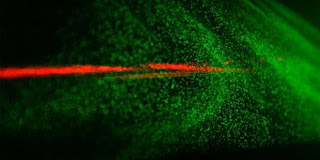Laser turns potentially be used to create rain. This was disclosed by Jerome Kasparian, a physicist from the University of Geneva. With these results, dry areas can expect more rain and scientists also got new techniques make it rain more effectively than the climate modification techniques.
In his research, Kasparian uses a laser to control the humidity. Scientists found that the laser can trigger the growth of raindrops on the humidity is lower, about 70 percent. "In the humidity, condensation does not occur in natural condition, where it takes 100 percent humidity," said Kasparian.
The secret is working laser beam on the ability of compounds to form nitric acid in the air. Nitric acid can be a "seed" clouds, choose to associate with water, acting like glue to form a body of water in relatively dry conditions, where water undergoes evaporation.
To be applied as the creator of the rain, still needs some development. Kasparian acknowledged that the laser can indeed grow watery particles. "However, the current size is limited, only a few microns. It takes 10 to 100 times more likely to produce rain the truth," Kasparian said.
Provided that these requirements can be met, the creation of rain with a laser would not be too difficult. No need to also air the laser system. "This type of laser is used for this work could reach a distance of several kilometers, so the atmosphere can be activated by ground-based lasers," Kasparian said as quoted by FoxNews, Tuesday (30/08/2011).
According to Kasparian, a combination of laser techniques and techniques of weather modification as a silver ice iodidan and Dru is not required. The move, according to him, it would be counterproductive. Particles will compete for the condensed water droplets and the result is too small, not enough to become raindrops.
One problem associated with the laser control is the weather like, will the creation of moisture in one place will steal moisture elsewhere. Responding to this, Kasparian said, "The laser allows only a small part of the condensation of moisture in the air." Thus, the risk is not too serious. The discovery is published in Nature Kasparian Communication, August 30, 2011.
skip to main |
skip to sidebar
Creating Rain from Laser
Advertisement
Labels:
Weather
Advertisement
Related Posts : Creating Rain from Laser
Entri Populer
-
Ice melting in the Arctic this year is very fast, approaching record levels that occurred in 2007. Thus the results of observations Roshydro...
-
The Kyoto Protocol set the six types of greenhouse gases, namely carbon dioxide (CO2), methane (CH4), nitrous oxide (N2O), and three industr...
-
Forest is an area overgrown with dense trees and other vegetation. Such areas are found in vast areas of the world and serves as a reservoir...
Related Site
Followers
Powered by Blogger.
All Contents Copyright © 2013 Think Environment™. Designed By Bengkel




0 comments:
Post a Comment